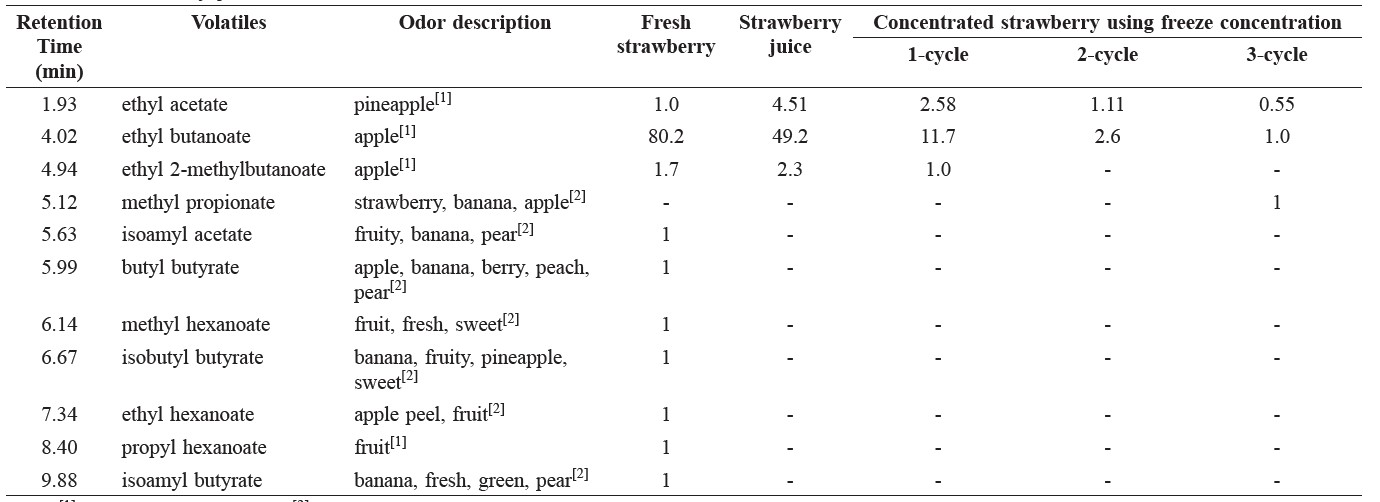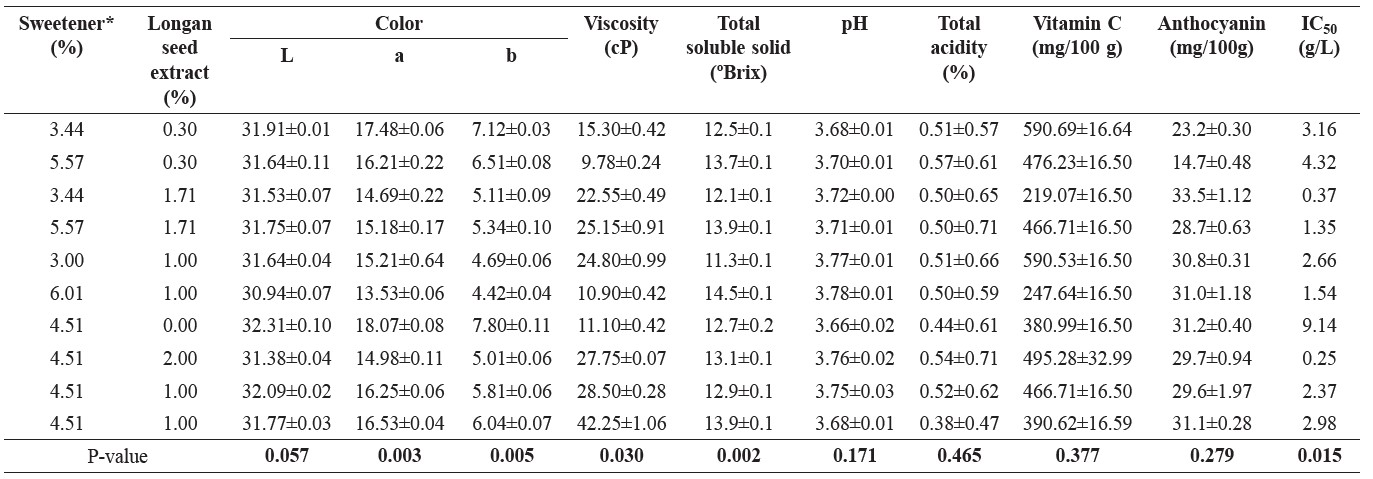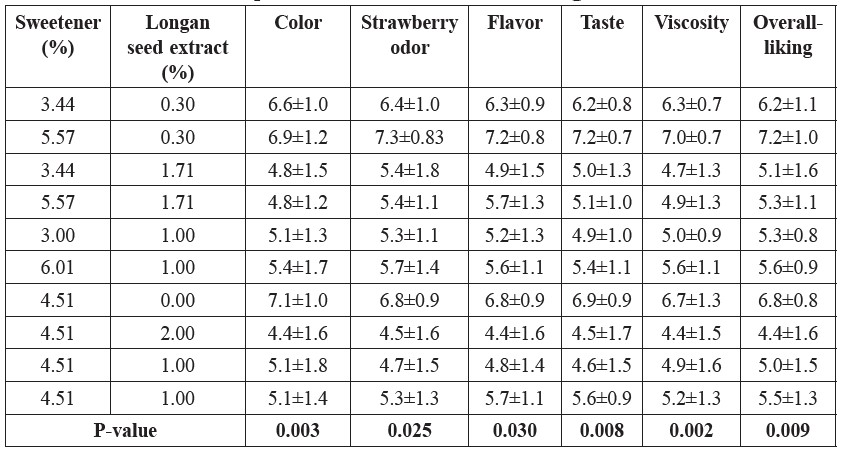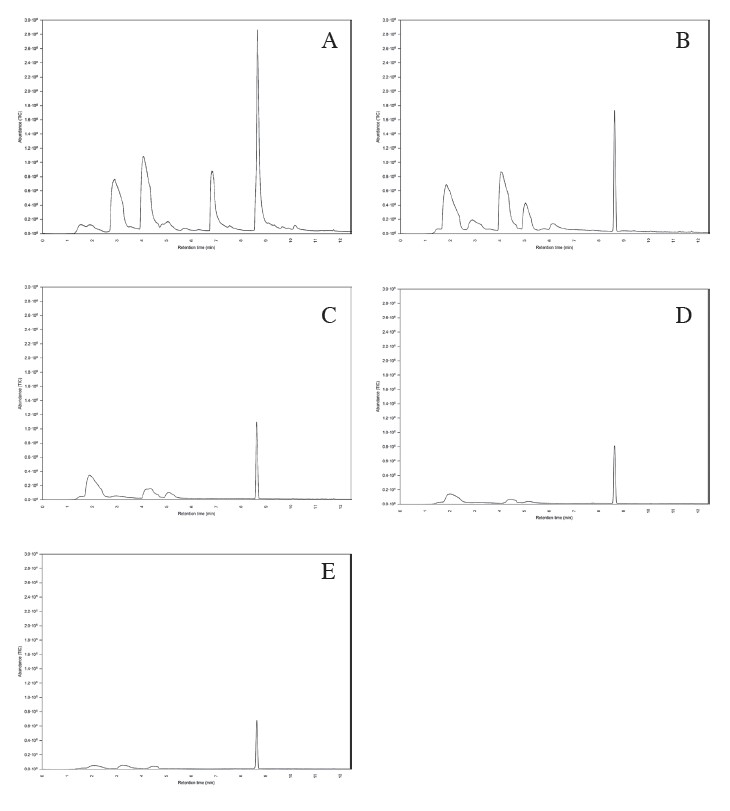
Development of a Concentrated Strawberry Beverage Fortified with Longan Seed Extract
Sujinda Sriwattana , Yuthana Phimolsiripol , Israpong Pongsirikul , Niramon Utama-ang , Suthat Surawang , Suwanna Decharatanangkoon , Yanisa Chindaluang , Jarinya Senapa , Wiwat Wattanatchariya , Sergio Angeli and Prodpran Thakeow*Published Date : 2019-08-24
DOI : 10.12982/CMUJNS.2015.0080
Journal Issues : Number 2, May - August 2015
ABSTRACT
Longan (Dimocarpus longan Lour.) is an important and economic crop in northern Thailand. Longan fruits can be consumed as fresh or processed products, such as canned longan, dried longan and longan in baked goods. Longan processing often consists of removing the shell and seeds that are then discarded. In fact, longan seeds contain phenolic compounds, which are antioxidants and free radical scavengers. Therefore, in this research we aimed to extract longan seeds (cultivar Edor) and fortify the crude extract into a concentrated strawberry beverage. The efficiency of two extraction solvents, hot water (70-75°C) and ethanol (70%), were compared. The total phenolic compounds of the crude extracts were 41.2 ± 0.2 and 11.7 ± 0.1 mg GAE/g for hot water and ethanol extraction, respectively. The strawberry concentrate was produced using a freeze-concentration process. The effect of the number of freeze cycles on the quality of the strawberry concentrate was also evaluated. The concentrated strawberry produced by two freezing cycles was selected to develop a beverage according to the richness in vitamin C, anthocyanin contents, and consumer acceptance. The optimized formula of concentrated strawberry beverage fortified with longan seed extract was 5.58% sweetener and 0.42% longan seed extract. This drink contained 248.73 mg/100 g vitamin C, 35.6 mg/100 g anthocyanin content, and 0.17 g/L DPPH free radical scavenging activity. An acceptance test using a 9-point hedonic scale showed that consumers (n=100) accepted the concentrated product with a ‘like very much’ judgment (7.2-7.7 marks). The concentrated strawberry beverage fortified with longan seed extract developed here offers several health benefits and shows potential as a commercial product.
Keywords: Antioxidation, Healthy drink, Extraction, Freeze concentration, Phenolic compound
INTRODUCTION
As consumers become more health conscious, interest in concentrated and fortified beverages is increasing, and its market share is growing (AAFC, 2010; Frost & Sullivan, 2010). Consumers are demanding a variety of beverage options, because of lifestyle and health concerns (De Angelis, 2013). Fruit juices are becoming popular, since they provide health benefits.
Strawberry (Fragaria × ananassa) is one of the most popular fruits worldwide, consumed both fresh and in processed products. In addition, strawberry colorings and flavorings are popular food additives. Strawberry fruits are also rich in anthocyanin, flavonoids, and phenolic compounds, in addition to the usual vitamins and minerals (Wang and Lin, 2000, Giampieri et al., 2012). Anthocyanin and ellagitannins are the major antioxidant compounds among the phytochemicals in strawberries. Compared to apple, peach, pear, grape, tomato, orange, or kiwifruit, strawberry has a 2 to 11-fold greater antioxidant capacity. Moreover, consumption of strawberries seems to be positively associated with a reduction in cardiovascular diseases, enhancing the neurological system and anti-proliferative activity (Giampieri et al., 2012).
Longan (Dimocarpus longan Lour.) seeds have long been considered a waste product of canned and dried longan processing. However, researchers recently have found that the extract of longan seeds contains antioxidant polyphenols, including corilagin, gallic acid, and ellagic acid, and thus offer potential health benefits (Rangkadilok et al., 2005, 2007; Panyathepa et al., 2013). The corilagin, gallic acid, and ellagic acid content, depending on cultivars, varied from 0-50.64, 9.18-23.04, and 8.13-12.65 mg/g DW, respectively. Among the longan cultivars, dried seeds of “Edor” contained high amounts of gallic acid and ellagic acid (Rangkadilok et al., 2007). The DPPH scavenging activity (SC50) of Japanese green tea and the fresh and dried seeds of longan cultivar Edor were similar at 10.2, 10.8, and 11.6 μg/mL, respectively (Rangkadilok et al., 2007). Yang et al. (2011) found that longan extracts from aril, pericarp or seed exhibited anti-tyrosinase, anti-glycated and anticancer activities, as well as memory-enhancing effects.
Recognizing these potential benefits, this study aimed to develop a new strawberry beverage fortified with longan seed extract, including studying the effect of longan seed extraction and strawberry juice concentration on the product.
MATERIALS AND METHODS
Extraction of longan seed
Longan seeds (cultivar Edor) were removed from the fruit and dried in a hot air oven (Memmert, Germany) at 75°C for 24 hrs. The final moisture content of the seeds was 2.5±0.2%. The dried seeds were milled by a blender (Moulinex, Spain) and sieved using 80-mesh screen. To prepare an extract of longan seeds, two types of extractions were performed. In the first extraction, the dried seed powder was suspended in hot water in a 1:4 weight/volume ration at 70-75°C for 1 hr. The suspension was then filtered and the seed residue was extracted another two times in the same procedure as described in Rangkadilok et al. (2007). The filtrate was collected and subjected to a vacuum rotary evaporator (Buchi, Japan) set at 50 mbar, 55°C and 50 rpm to remove the water from the extract.
In the second extraction, the dried seed powder was extracted using 70% ethanol with a ratio of 1:12.5 weight/volume. The mixture was left overnight, and then filtered. The seed residue was extracted twice, and the filtrates were pooled together. The solvent was removed using a vacuum rotary evaporator.
In the last step, both condensed extracts were further freeze-dried. The obtained powder of longan seed extract was kept at 4°C for further analysis and application.
Preparation of concentrated strawberry juice
Strawberries (cultivar 329 Yale) were purchased from a local market in Chiang Mai, Thailand. The total soluble solid (TSS) was controlled in a range of 7-9°Brix. A completely randomized design was used in the preparation of the strawberry concentrate using a freeze-concentration method. Strawberries were washed and stems were removed. Strawberry juice was obtained using a juicer (BUO-143573, Buono, Korea). The juice was partially frozen using an ice cream maker (Gamma 50S, Corema, Italy), where water formed ice crystals. The slurry was then centrifuged in order to remove ice and concentrate the juice. Concentrated juices obtained by one, two, and three cycles of concentration were compared in aspects of physical, chemical, and sensory properties.
Preparation of concentrated strawberry juice fortified with longan extract
The experiment used a central composite design with two factors – 0.0-2.0% of longan extract and 3.0-6.0% of sweetener (0.17% of sucralose in sucrose) – for 10 treatments. The concentrated strawberry juice was mixed with longan seed extract and sweetener, and then pasteurized at 86°C for 15 min, and bottled. The chemical, physical, and sensory properties of the ten samples were analyzed.
Analysis of physical properties
The physical properties, including color Lab (Color Quest XE, Hunter Lab, USA), TSS (Master-2m, ATAGO, Japan) were analyzed. Viscosity of the juice was examined using a viscometer (Brookfield viscometer, DV-II, USA). The measurement was carried out using spindle no. 18 with shear rate 60 rpm at 25°C.
Analysis of chemical properties
The pH of the concentrated juices was measured using a pH meter (model 827, Metrohm, Switzerland). The total acid and vitamin C contents were analyzed according to AOAC (2000). The anthocyanin content of the juices was analyzed by mixing 0.1 g of strawberry juice with 10 mL acidified methanol (85 mL of methanol and 15 mL of 1 M hydrochloric acid). The solutions were shaken for 3 min (Unimax 2010, Heidolph, Germany), and then centrifuged for 10 min at 2500g (Universal 320R, Hettich, Germany). Subsequently, the optical densities were measured at 525 nm (Genesys 10UV scanning, Thermo, USA). The anthocyanin content was calculated by comparing with the standard curve of cyaniding-3-glucoside (Sompong et al., 2011). DPPH free radical scavenging activity was determined as described by Tennyson et al. (2012). The optical densities of the sample solutions were measured at 515 nm, and subsequently the half maximal inhibitory concentrations (IC50) were calculated.
Volatile organic compounds (VOCs) of fresh strawberry, strawberry juice, and concentrated juice (1, 2, and 3 cycles of freeze-concentration) were investigated. Nine grams of samples were added to a 25-mL vial. The VOCs of each sample were analyzed using solid-phase micro-extraction (SPME) and gas chromatography-mass spectrometry (GC-MS, HP 6890N-MS, 5973, Agilent Technologies, USA). The SPME fiber was carboxen/polydimethylsiloxane (Supelco, USA). The fiber was inserted into the headspace of the vials containing samples, and exposed for 30 min. Afterwards, the fiber was injected into the injection port of the GCMS. An initial temperature of 40°C was held for 1.5 min, then the temperature was increased to 200°C using a heating rate of 6°C/min. Helium gas was used as the carrier gas with flow rate 53.9 mL/min. The mass scan range was 50-550 amu. The results were interpreted by comparing with the database of The National Institute of Standards and Technology (NIST, Gaithersburg, USA). The results were reported as relative area ratio by comparing each compound.
Sensory evaluation
Consumer acceptance of the fresh and concentrated juices was evaluated using a 9-point hedonic scale. The consumers (n=50) individually examined the samples in testing booths. The juices were kept in a refrigerator prior to testing; the consumers were given 40 mL samples of the cool juices to test.
Statistical analysis
The experimental design, data analysis, and optimization were carried out using Minitab (version 16.1.1.0, Minitab Inc., Pennsylvania, USA). Significance level was 0.05 for all experiments.
RESULTS
Effect of longan seed extraction on total phenolic content
The total phenolic content (TPC) of the hot water extract was higher than that of the ethanol extract. TPC of the crude extracts was 41.2 ±0.2 and 11.7 ±0.1 mg GAE/g for the longan seed extracts obtained by water and ethanol extraction, respectively.
Effect of freeze-concentration cycles on concentrated strawberry juices
The physical and chemical properties of fresh and concentrated strawberry juices after different numbers of freeze-cycles are shown in Table 1. The freeze concentration significantly affected the physical and chemical properties of the juices (P<0.05). The color of the concentrated juices was dark red, with the ‘a’ color value ranging from 14.51 to 16.89. TSS increased from 7.9°Brix in the fresh juice to 10.7°Brix in the juice produced by three cycles of freeze concentration. Consequently, the viscosity significantly increased also (P<0.05).
Table 1. Physical and chemical properties of fresh and concentrated strawberry juices.

Note: Values are mean ± standard deviation. Different superscripts in the same column denote significant differences (P<0.05). FC1, FC2, and FC3 are concentrated strawberry juice using freeze concentration for 1, 2 and 3 cycles, respectively.
Total acidity, anthocyanin content, and free-radical scavenging activity (as IC50) significantly increased (P<0.05) with increasing cycles of freeze concentration. In contrast, vitamin C content decreased from 422 mg/100 mL (fresh juice) to 233 mg/100 mL (juice produced by three cycles of freeze concentration). Table 2 and Figure 1 show the volatile organic compounds (VOCs) of fresh strawberry, strawberry juice, and concentrated strawberry juices (one, two, and three cycles of freeze concentration). HS-SPME detected 11 VOCs: ethyl acetate, ethyl butanoate, ethyl 2-methylbutanoate, methyl propionate, isoamyl acetate, butyl butyrate, methyl hexanoate, isobutyl butyrate, ethyl hexanoate, propyl hexanoate, and isoamyl butyrate.
Sensory evaluation of the strawberry juices (Table 3) revealed that flavor and overall liking were significantly different (P<0.05), while the other three attributes (color, strawberry odor, viscosity) were not different. The strawberry juice produced by two cycles of freeze concentration was the most acceptable, with flavour and overall hedonic scores of 5.8 and 5.7, respectively, although the consumers suggested that the juice was too sour and not sweet enough. This two-cycle, freeze-concentrated juice was selected for further experimentation.
Effect of sweeteners and longan seed extract on concentrated strawberry juice properties
It can be seen in Table 4 that adding sweeteners and longan seed extract significantly darkened the color (a and b) and increased the viscosity and TSS of the concentrated juices (P<0.05). It did not, however, significantly affect the vitamin C or anthocyanin content. In contrast, adding the extract significantly affected the IC50 of the juice.
Sweeteners and longan seed extract significantly influenced consumer acceptance (n=50) in all attributes (Table 5, P<0.05). When comparing juices with the same quantity of sweetener added (4.51% of strawberry juice), the consumers preferred the color of the juice without the longan seed extract (score of 7.1±1.0). The juice containing the most longan seed extract (2.0%) was the least liked, with a score of 4.4. For juices with the same quantity of longan seed extract (0.3%), consumers preferred the one with 3.44% of sweetener added. When the sweetener quantity was increased (5.57%), the juice obtained the highest score of 7.2. This indicated that consumers preferred more sweetener, and less longan seed extract. Table 6 shows the regression parameters for optimizing the ingredient quantities; the optimum sweetener and longan seed extract quantities were 5.58% and 0.42%, respectively.
Analysis of the optimized-concentrated strawberry juice fortified with longan seed extract
The final product of concentrated strawberry juice was prepared by adding the optimized sweetener (5.58%) and longan seed extract (0.42%) to the 2-cycle freezing concentrated strawberry juice. The juice color was dark red. The color values of L, a, and b were 32.10, 17.96, and 7.22, respectively. The viscosity was 214 cPs and total soluble solid was 13.47°Brix. The pH of the juice was 3.82. The vitamin C and anthocyanin contents were 248.73 and 35.6 mg/100 g, respectively. The IC50 was 0.17 g/L, which was higher than the non-fortified juice. The final product was tested with consumers (n=100) to evaluate their acceptance using a 9-point hedonic scale of color, strawberry flavor, viscosity, overall flavor, overall taste, and overall liking. The consumers scored the developed concentrated strawberry fortified juice as liked moderately to liked very much (score of 7.2-7.7).
Table 2. Volatile compounds, odor description and relative ratios for fresh strawberry, strawberry juice, and freeze-concentrated strawberry juice.

Note: [1]http://www.flavornet.org, [2]http://www.thegoodscentscompany.com
DISCUSSION
Phenolic compounds possess one or more aromatic rings with one or more hydroxyl groups. More than 8,000 phenolic structures have been discovered (Dai and Mumper, 2010). The main phenolics of longan seed are corilagin, gallic acid, and ellagic acid (Rangkadilok et al., 2005, 2007; Panyathepa et al., 2013). Solvent selection affects the extraction of phenolic compounds. In our study of longan seeds, water was a better extraction solvent than ethanol. This was probably due to the fact that the phenolic compounds in longan seeds are high polarity and readily dissolved in water. In addition, increasing the extraction temperature enhanced the compound solubility.
Freeze-concentration is a technique that extracts water from products, while retaining its good properties, for instance, aroma and bioactive compounds. In our experiment, strawberry juice obtained from a juicer was concentrated by freezing for one to three cycles. Different cycles of freeze-concentration altered the physical and chemical properties of the concentrated juiced obtained. For example, the viscosity significantly increased (P<0.05) when the freeze cycle increased, due to increasing removal of free water from the juices. In addition, the TSS also increased. However, these changes did not affect consumer acceptance. Of note, increasing the number of freeze cycles decreased the vitamin C content of the juice. This was probably due to vitamin C’s water-solubility, so as more water was removed, more vitamin C was correspondingly removed. The volatile compounds detected in strawberry juice are esters, contributing to its sweet and fruity aroma. Ten VOCs were detected in fresh strawberry. Only three of these remained after one cycle of freeze concentration: ethyl acetate, ethyl butanoate, and ethyl 2-methylbutanoate remain. Ethyl 2-methylbutanoate was not detected in the concentrated juiced produced by 2 and 3 cycles of freeze concentration. In the three-cycle concentrated sample, methyl propionate was detected for the first time, in addition to the ethyl acetate and ethyl butanoate that remained. Methyl propionate was probably present in minute amounts in the non-concentrate and, when the juice was concentrated, this compound was then concentrated to detectable quantities through three cycles of freeze concentration. Interestingly, in our experiment, furanone, which contributes to the typical strawberry aroma, was not found, although it may have been present in trace amounts. It has been reported that the lowest concentration of furanone that humans can detect is approximately 0.05 ppm (Bharate and Bharate, 2012). Du et al. (2011) reported that ethyl butanoate contributed to the highest odor activity values (OAVs) in the strawberry cultivar festival; in our experiment, this compound gradually decreased as the
strawberry was concentrated (Table 2).
Table 3. Sensory evaluation of fresh and concentrated strawberry juices.

Note: Values are mean ± SD. Different superscripts in the same column denote significant differences (P<0.05). ns indicates no significant difference (P≥0.05). FC1, FC2, and FC3 are strawberry juice with freeze concentration for 1, 2, and 3 cycles, respectively.
Table 4. Physical and chemical properties of concentrated strawberry juices with different quantities of sweetener and longan seed extract added.

Note: * Sweetener was 0.17% of sucralose in sucrose.
The two-cycle concentrate received the highest consumer scores. This was likely affected mainly by its flavor, which include taste and aroma. Adding longan seed extract into the strawberry juice significantly affected the IC50 of the juice. This was due to the antioxidant properties of the phenolic compounds (Rangkadilok et al., 2007). Because of the bitterness of the longan seed extract, consumers preferred the least fortified juice. Consumers accepted the developed concentrated strawberry juice fortified with longan seed extract and the addition of sweetener. The optimum quantities of longan seed extract and sweetener were 0.42% and 5.58%, respectively. The concentrated strawberry juice fortified with longan seed extract developed here shows potential as a commercial product.
Table 5. Sensory scores (9-point hedonic scale) of concentrated strawberry juices with different quantities of sweetener and longan seed extract added.

Table 6. Regression equations of concentrated strawberry juices with different quantities of sweetener and longan seed extract added.


Figure 1. Chromatograms of volatile compounds of (A) fresh strawberry, (B) strawberry juice, and (C, D, E) concentrated strawberry juice using freeze concentration for 1, 2, and 3 cycles, respectively, using SPME technique (TIC: total ion current).
ACKNOWLEDGEMENTS
The authors would like to thank the Research Cluster, Faculty of Agro-Industry, Chiang Mai University, Thailand for its financial support. Moreover, the laborious work of bachelor students Ms. Pathama Suriyanakorn and Ms. Sarawadee Manawakul is also acknowledged.
REFERENCES
Agriculture and Agri-Food Cananad. 2010. Market indicator report: Consumer trends non-alcoholic drinks in Thailand. ISSN 1920-6615 Market Indicator Report AAFC No. 11303E: 13 pp.
Bharate S.S., and S.B. Bharate. 2012. Non-enzymatic browning in citrus juice: chemical markers, their detection and ways to improve product quality. Journal of Food Science and Technology DOI 10.1007/s13197-012-0718-8.18 pp.
Dai J., and R.J. Mumper. 2010. Plant phenolics: extraction, analysis and their antioxidant and anticancer properties. Molecules 15: 7313-7352.
De Angelis, A. 2013. Global Beverage Market, 11 April 2013. http://www.companiesandmarkets.com/MarketInsight/Food-and-Drink/Global-Beverage-Market/NI6953 (February 20,2014).
Du X., A. Plotto, E. Baldwin, and R.J. Rouseff. 2011. Evaluation of volatiles from two subtropical strawberry cultivars using GC-olfactometry, GC-MS odor activity values, and sensory analysis. Journal of Agriculture and Food Chemistry 59(23):12569-77.
Frost & Sullivan 2010. Global nutraceutical industry: Investing in healthy living. Mumbai, India: 50 pp.
Giampieri, F., S. Tulipani, J.M. Alvarez-Suarez, J. L. Quiles, B. Mezzetti, and M. Battino. 2012. The strawberry: composition, nutritional quality, and impact on human health. Nutrition 28: 9-19.
Panyathepa, A., T. Chewonarina, K. Taneyhillb, Y-J.Surhc, and U. Vinitketkumnuena. 2013. Effects of dried longan seed (Euphoria longana Lam.) extract on VEGF secretion and expression in colon cancer cells and angiogenesis in human umbilical vein endothelial cells. Journal of Functional Foods 5:1088-1096.
Rangkadilok, N., L. Worasuttayangkurn, R.N. Bennett, and J. Satayavivad. 2005. Identification and quantification of polyphenolic compounds in longan (Euphoria longana Lam.) fruit. Journal of Agricultural and Food Chemistry 53: 1387-1392.
Rangkadilok, N., S. Sitthimonchai, L. Worasuttayangkurn, C. Mahidol, M. Ruchirawat, and J. Satayavivad. 2007. Evaluation of free radical scavenging and antityrosinase activities of standardized longan fruit extract. Food and Chemical Toxicology 45:328-336
Wang, S.Y., and H-S. Lin. 2000. Antioxidant activity in fruits and leaves of blackberry, raspberry, and strawberry varies with cultivar and developmental stage. Journal of Agricultural and Food Chemistry 48: 140-146.
Yang, B., Y. Jianga, J. Shib, F. Chenc, and M. Ashraf. 2011. Extraction and pharmacological properties of bioactive compounds from longan (Dimocarpus longan Lour.) fruit-A review. Food Research International 44(7): 1837-1842.
Sujinda Sriwattana1,2, Yuthana Phimolsiripol1, Israpong Pongsirikul1,2, Niramon Utama-ang1,2, Suthat Surawang1,2, Suwanna Decharatanangkoon1, Yanisa Chindaluang1, Jarinya Senapa1,2, Wiwat Wattanatchariya1, Sergio Angeli3 and Prodpran Thakeow1*
1 Division of Product Development Technology, Faculty of Agro-Industry, Chiang Mai University, Chiang Mai 50100, Thailand
2 Sensory Evaluation and Consumer Testing Unit, Faculty of Agro-Industry, Chiang Mai University, Chiang Mai 50100, Thailand
3 Faculty of Science and Technology, Free University of Bozen-Bolzano, Italy
*Corresponding author. E-mail: prodpran.t@cmu.ac.th
Total Article Views

